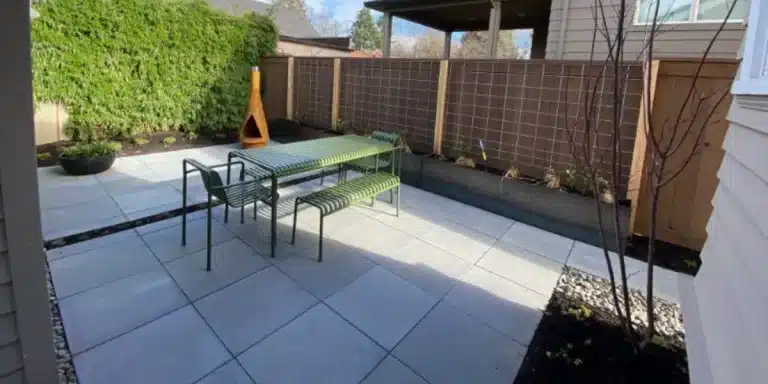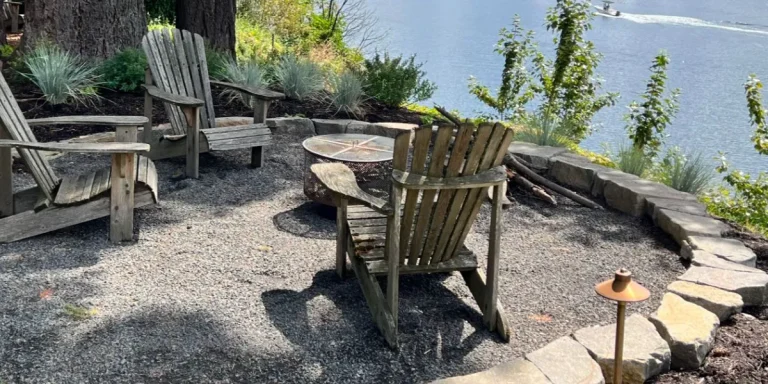Why Your Patio Needs Edge Restraints and Joint Sand
When it comes to building a long-lasting patio, it’s easy to focus on the visible features—beautiful pavers, intricate patterns, and clean lines. But what keeps your patio looking great and functioning properly year after year often comes down to the components you can’t see. Two of the most important are edge restraints and joint sand.
Without these elements, your patio is vulnerable to shifting, settling, and weed growth. Let’s take a closer look at why these details matter and how proper installation by professionals makes all the difference.
What are edge restraints?
Edge restraints are essential structural elements that secure the outer perimeter of a paver patio. Their primary role is to lock the pavers in place, preventing lateral movement caused by everyday use, seasonal temperature shifts, or freeze-thaw cycles common in the Pacific Northwest.
Without edge restraints, even a well-built patio can begin to deteriorate at the edges, with pavers drifting out of alignment over time. These subtle shifts may seem minor at first but often lead to more serious issues like surface instability, trip hazards, and uneven settling.
Why edge restraints matter
Edge restraints play a crucial role in the long-term integrity of your hardscape. Here’s what they help prevent:
-
- Paver separation: When pavers are left unsupported at the perimeter, they can slowly migrate outward under the pressure of foot traffic or environmental stress.
- Base material loss: Without containment, the compacted gravel and bedding sand beneath your pavers can shift or erode—leading to sunken spots and instability.
- Structural breakdown: Over time, the loss of cohesion along the edge can lead to complete patio failure, requiring costly repairs or even full replacement.
By creating a solid boundary, edge restraints ensure that the hardscape remains locked together, allowing the surface to age gracefully and withstand changing conditions.
Common types of edge restraints we install
We tailor edge restraint materials to match the design, function, and shape of each patio. The most effective options include:
-
- Steel or aluminum: These are ideal for clean, modern patios with straight edges. They’re low-profile but extremely strong and durable, making them a favorite for contemporary designs.
- Concrete curbing: Cast-in-place concrete borders offer maximum strength and are perfect for formal or high-traffic installations. They can also be textured or colored to match your pavers.
- Plastic edge systems: Flexible and cost-effective, plastic restraints work well for patios with curved layouts or intricate patterns. When anchored properly, they provide excellent performance over time.
Each of these materials is anchored into the base using long spikes to ensure they stay firmly in place. Proper installation is key—poorly secured or misaligned restraints can compromise the entire project.
Why edge restraints fail
We’ve seen many cases where patios began to shift simply because the edge restraint was an afterthought. Common mistakes include:
-
- Using the wrong restraint for the patio shape or materials
- Failing to install deep enough spikes for anchoring
- Skipping restraint installation entirely on one or more sides
At White Oak Landscapes, we never treat edge restraint as optional. It’s a foundational step in every paver patio we build—one that protects your investment for the long haul.
What is joint sand?
Joint sand is the fine material swept between the cracks of paver patios to lock the surface together and improve performance. While it may seem like a minor detail, joint sand plays a critical role in the stability, durability, and long-term appearance of your patio.
When installed correctly, joint sand creates friction between pavers, helping to keep them in place under the pressure of foot traffic, outdoor furniture, and even light vehicles (if applicable). Without it, pavers are more likely to shift, settle unevenly, or develop gaps where weeds and pests can take hold.
Why joint sand is essential
A quality patio isn’t just about what’s under the surface—it’s also about what fills the space between the pavers. Here’s why joint sand matters:
-
- Stabilizes the surface: It helps distribute weight evenly across each paver, minimizing movement or tilting when walked on.
- Discourages weed growth: Tightly packed joints prevent seeds from settling into the cracks and germinating.
- Blocks pests: Properly filled joints deter ants and other insects from nesting in the base layers of your patio.
- Improves drainage: Joint sand allows water to flow downward between pavers, helping to prevent puddles on the surface while supporting your patio’s overall drainage design.
Without joint sand—or with poorly installed sand—your patio is far more likely to suffer from shifting, weed problems, and premature wear.
What is polymeric sand—and why it’s better
At White Oak Landscapes, we use polymeric sand for most of our paver patio projects across Oregon City and surrounding areas. Unlike standard joint sand, polymeric sand contains special binders that activate when exposed to water. This causes the sand to harden slightly, forming a flexible, semi-solid joint that’s more resistant to erosion and movement.
Benefits of polymeric sand
-
- Superior durability: Once cured, polymeric sand resists being washed out by heavy rain, wind, or power washing.
- Reduced maintenance: It minimizes weed growth and prevents joint erosion, saving homeowners time and money on upkeep.
- Cleaner appearance: Polymeric sand helps keep joints neat and uniform, enhancing the overall look of your patio.
- Water permeability: While it hardens, it still allows water to drain through—helping preserve the base and reduce pooling.
We’ve completed patios in Oregon City, West Linn, Clackamas, and surrounding towns that still look great years after installation, thanks to the stability that polymeric sand provides. When combined with proper compaction and sealing, it’s one of the best ways to protect your investment long-term.
What happens when you skip these steps
Unfortunately, we’ve seen many DIY or rushed installations where edge restraints and joint sand were ignored—or done poorly. Here’s what typically happens:
-
- Pavers begin to drift apart within months
- Weeds sprout up between gaps
- Rainwater washes away the base layer, leading to sinking spots
- The patio becomes uneven and unsafe to walk on
In these cases, homeowners often end up paying more for repairs than they would have for proper installation in the first place.
How we build patios that last
At White Oak Landscapes, we install every patio with longevity in mind. That means:
-
- Excavating and compacting the base correctly
- Using geo-fabric to separate soil from base material
- Installing edge restraints that match your layout and traffic levels
- Applying and compacting polymeric sand to lock in your pavers
We build outdoor spaces that stay beautiful and functional—season after season.
Proudly serving Oregon City and beyond
We provide professional patio installation and hardscaping services in:
-
- Oregon City
- West Linn
- Lake Oswego
- Happy Valley
- Clackamas
- Milwaukie
- Tualatin
- Wilsonville
- Canby
- Gladstone
- Beavercreek
- Estacada
- Damascus
Get a patio that performs—season after season
Let’s build your patio the right way. If you want a paver patio that stays level, weed-free, and beautiful for years to come, we’re ready to help. Request a free estimate today and let’s talk about your space and goals.
White Oak Landscapes is your trusted patio contractor in Oregon City and the surrounding areas—and we stand by every project we build.
